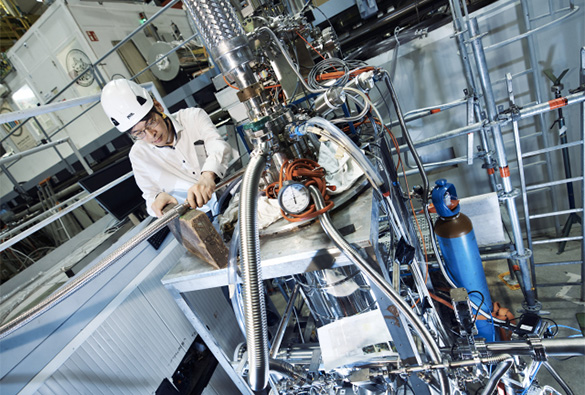ASACUSA sees surprising behaviour of hybrid matter –antimatter atoms in superfluid helium

The ASACUSA collaboration has reported the unexpected behaviour of a hybrid matter–antimatter helium atom immersed in superfluid helium. The results are described in a paper recently published in the journal Nature.
The ASACUSA (Atomic Spectroscopy And Collisions Using Slow Antiprotons) collaboration uses the Radio Frequency Decelerator downstream of Antiproton Decelerator at CERN to make hybrid matter–antimatter helium atoms containing an antiproton instead of one of the electrons. Then they use precision laser spectroscopy to determine the antiproton’s mass and compare it with that of the proton.
These hybrid atoms are made by mixing the antiprotons with a low-density helium gas at low temperature. Low gas densities and temperatures have played a key role in the spectroscopic measurements of the hybrid atoms, as high gas densities and temperatures result in spectral lines that are too broad to allow the mass of the antiproton to be determined.
This is why it came as surprise to the ASACUSA researchers that, when liquid helium was used instead of gaseous helium, they saw a decrease in the width of the antiproton spectral lines. Moreover, when they decreased the temperature of the liquid helium so that it became superfluid, they found an abrupt further narrowing of the spectral lines.
The researchers think that the surprising behaviour observed is linked to the radius of the electronic orbital, which, in the case of the hybrid atoms, changes very little when laser light is shone on them. Therefore, it would not affect the spectral lines even when the atom is immersed in superfluid helium. However, further studies are needed to confirm this hypothesis.
The result has several implications. Firstly, researchers may create other hybrid helium atoms, such as pionic helium atoms, in superfluid helium to measure the particle masses by laser spectroscopy. Secondly, the substantial narrowing of the lines in superfluid helium suggests that hybrid helium atoms could be used to study this form of matter and potentially other condensed-matter phases. Finally, the narrow spectral lines could be used to search for cosmic low-energy antiprotons or antideuterons that hit the liquid helium used to cool experiments in space or in high-altitude balloons.
The full article can be found in:
Sótér, A., Aghai-Khozani, H., Barna, D. et al.
High-resolution laser resonances of antiprotonic helium in superfluid 4He
Nature 603, 411–415 (2022).